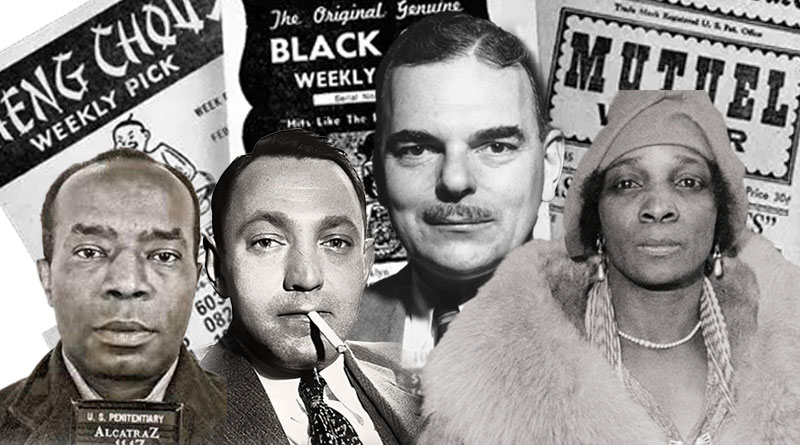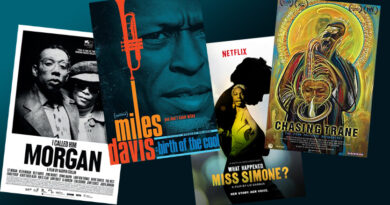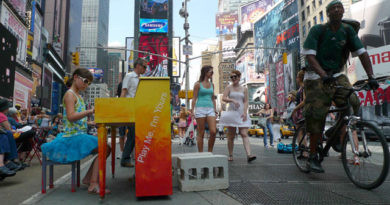Numbers in Harlem

Where could one, separated by social and economic racism and segregation, play a three-digit number for $1 (considered a large investment at the time) and if one “hit the number” straight, get a return of $600? It was in Harlem! That’s one of several reasons why playing the numbers was so popular back then and remains popular to this very day. Introduced to Harlem in the early 1900s, playing the numbers eventually grew by leaps and bounds. The numbers game was an extremely lucrative business and employed a great many people in the community who otherwise couldn’t get a job.
How it All Began
As legend has it, it all started with a man of African descent, named Casper Holstein, born in 1876, who immigrated from St. Croix to Harlem as a young boy in 1894. As an adult, Casper was hired as a porter and worked for a brokerage firm on Wall Street. He took interest in the stock market and how the system worked. One day, sitting among his mops and brooms in his hot janitor’s closet, Casper came up with the idea of “playing the numbers.” He became known as the Bolita King (one who plays any combination of two numbers) and went on to make a tremendous fortune in the numbers game. Casper, operating his Harlem “office” out of 136th Street, just off Eighth Avenue, was making up to almost $12,000 a day at his height in the numbers game (by today’s standard, around $250,000 daily).
Selfless by nature, Casper Holstein set the example for future number bankers with his generosity. He donated money to Black colleges, churches, Black causes, and countless poor children in Harlem. He even aided the career of many Harlem Renaissance writers by creating the annual Holstein Prize (at the time called the Opportunity Contest), where $1,000 was given “for fostering of creative literary expression among Negroes.” Casper owned some of the finest buildings in Harlem, a slew of expensive cars, a beautiful home on Long Island, and thousands of acres of land in Virginia.
All Hail the Queen
But it was Stephanie St. Clair and the “Forty Thieves,” operating out of 144th Street between Lenox and Seventh Avenues, who took the numbers game to a “whole ‘nother level.” She also drew the attention of the Mob that later led to turf battles over this lucrative enterprise.
Born in Martinique, St. Clair immigrated to the United States in 1912, by way of Marseilles, France. Just ten years after arriving to this country, the elegant but tough-as-nails, French-speaking woman made a bold and daring move in 1922. Seeing the potential of what Casper Holstein developed, St. Clair took $10,000 of her own money and opened a numbers bank in Harlem on 140th Street and Seventh Avenue. It was right after this that St. Clair was respectfully referred to as “Queen,” “Madame St. Clair” or “Madame Queen” by Harlemites, while the hustlers referred to her as “The Dragon Lady.” This extraordinary woman and her “Forty Thieves” had such a reputation that even white gangsters didn’t mess with them. Madame St. Clair not only had persuasive powers, but extraordinary leadership as well; so much so that within a year after setting up her numbers bank, she accrued personal wealth of more than a half-million dollars and had over 40 number runners and 10 bankers (also known as controllers) under her. Remember, back in the days of Madame St. Clair, the people of Harlem were playing the numbers for nickels, dimes, and pennies; so the volume generated in order for her to make a halfmillion dollars is impressive!
They’re Everywhere
The numbers were played out of barber shops, beauty salons, pool halls, restaurants, grocery stores, cleaners, drugstores, bars—you name it! And with such a volume of nickels, dimes, and pennies coming in each day, it was virtually impossible for the bankers to lose in the numbers business. Furthermore, having the numbers in these establishments brought in additional business for these venues. Overall, the numbers in Harlem created thousands of jobs, from number runners to number holes and even down to those whose sole jobs were to give the numbers at certain times during the day. With the introduction of Prohibition against liquor and beer across the United States on January 16, 1920, and the coming of the Great Depression, in October, 1929, the Mob turned its attention to the numbers game in Harlem.
Numbers King
One such Mob figure was Arthur Simon Flegenheimer, better known as “Dutch Schultz.” Schultz, also called the “Beer Baron,” grew powerful as a result of controlling the production and distribution of beer and liquor in Harlem during Prohibition. But it was the powerful, Tammany Hall, politically connected Democratic boss, James J. Hines, who brought the “profitability” of the numbers racket to the attention of Dutch Schultz. As a result, Schultz, “Lucky” Luciano, Frank Costello, “Bugsy” Siegel, Meyer Lansky, and other mobsters began to muscle in on the numbers game spurred on by the need to compensate for lost revenues from their other vices due to the Great Depression. The takeover was swift.
Within a short time, Dutch Schultz was named “King of the Harlem Bankers.” The word on the street was: you either worked for Dutch Schultz, or you didn’t work at all. However, there were a few in the Black community who fought back: Casper Holstein, Madame St. Clair, and the legendary Ellsworth “Bumpy” Johnson. But Holstein, because of the lack of black political clout and protection, was actually kidnapped by the Mob. He was later arrested on a federal warrant for illegal gambling and policy violations and served one year in prison. By the time he returned to Harlem, the Mob had taken over his business.
Madame St. Clair, despite consistently paying for police protection, was constantly harassed by them, so she ran ads in the Harlem papers, such as the New York Amsterdam News, charging police corruption. They retaliated by arresting her on trumped-up charges, and she was imprisoned for nearly a year. The indomitable St. Clair, when released, struck back by testifying before the Seabury Commission about her numbers business and her payoffs to the police department. As a result, over a dozen officers involved were suspended. Because of lack of protection from other Harlem number bankers, she became a marked woman and went into hiding for a short time. Although she eventually worked for Dutch Schultz, she hated him. She never forgot what he did to her and her lucrative numbers business. With the repeal of Prohibition in 1933, Fiorello LaGuardia, the mayor of New York, appointed a bright young attorney named Thomas E. Dewey to the position of special prosecutor. One of the first mandates given to Dewey was to clean up the corruption in Tammany Hall and throughout the city. One of Dewey’s initial targets was Dutch Schultz. Schultz, in retaliation, wanted to “put out a hit” on the special prosecutor. The Syndicate felt it wiser to avoid additional pressure and publicity on the organization and opted to “rub out” Dutch instead. On October 23, 1935, Schultz was gunned down. As he lay close to death in Newark City Hospital, a Western Union telegram was sent to Dutch Schultz that read: “As ye sow, so shall ye reap,” sent by none other than Madame St. Clair herself. Schultz died the following evening at the age of 33.
Bumpy Takes the Throne
Ellsworth Raymond Johnson was born in 1905, in South Carolina. He came to New York at age five to live with his oldest sister and attend Boys High School. He got his nickname as a result of “bumping” the other guys around on the basketball court. “Bumpy” was later known for his dapper style, wearing the latest “vines” (clothes) and always having a “knot” (a wad of money) the size of his fist. What established Bumpy Johnson other than these outward trappings, were his fearlessness and his temper. It was rumored he always carried both a knife and a gun and had no problem using either one.
It was Madame St. Clair who saw this quality in Bumpy and brought him into the Forty Thieves. He was her enforcer, pure and simple; and Bumpy got the job done. Even when Dutch Schultz was in the process of taking over Harlem’s numbers business, he had to approach Bumpy Johnson differently. Bumpy was later given the highest Black position possible in Schultz’s mob; he became responsible for control of Schultz’s Harlem numbers and enforcing Mob policy here. Eventually, if one wanted to buy a numbers bank franchise in Harlem, one went to Bumpy Johnson (for a fee, of course!). As a result, he became known as “the Persuader.”


